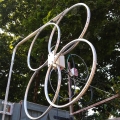Good signals into the UK this morning from SAQ on 17.2KHz using an historic alternator transmitter
https://alexander.n.se/?lang=en15dB above the noise floor into Farnham WEB SDR
http://farnham-sdr.… (more) com/ in SE UK
12dB above the noise floor into Kernow KiWI WEB SDR http://kernow.hopto.org:8073/ at Goonhilly Earth Station in Cornwall SW tip of UK (despite a very high noise floor)
Unfortunately too much switched mode power supply noise on my SWUK KiWi SDR http://southwest.ddns.net:8073/ which masked the SAQ signal.
Another transmission due later today at 13.30 (11.30 UTC) the alternator starts and at 14.00 (12.00 UTC) will be broadcasting a message
Martin G8JNJ (Admin for Farnham / Kernow and SWUKSDR) (less)












